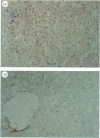Abstract
The CD1 gene family is composed of five distinct molecules: CD1a, b, c, d and e. CD1a, b and c are primarily expressed thymically with limited extrathymic expression. Preliminary studies have shown that CD1d is primarily expressed extrathymically in gastrointestinal epithelial cells, renal tubular epithelial cells and B cells. This report characterizes the expression of CD1d in a variety of human tissues by immunohistochemistry using two anti-human CD1d monoclonal antibodies (mAb). CD1d was found in a wide range of tissues including the intestine, liver, pancreas, skin, kidney, uterus, conjunctiva, epididymis, thymus and tonsil. Within those tissues CD1d was mainly present in epithelial cells, vascular smooth muscle cells and parenchymal cells. Therefore, the tissue distribution of CD1d is distinct from CD1a-c and classical major histocompatibility complex (MHC) proteins implicating a unique role for CD1d in the immune system.
Full text
PDF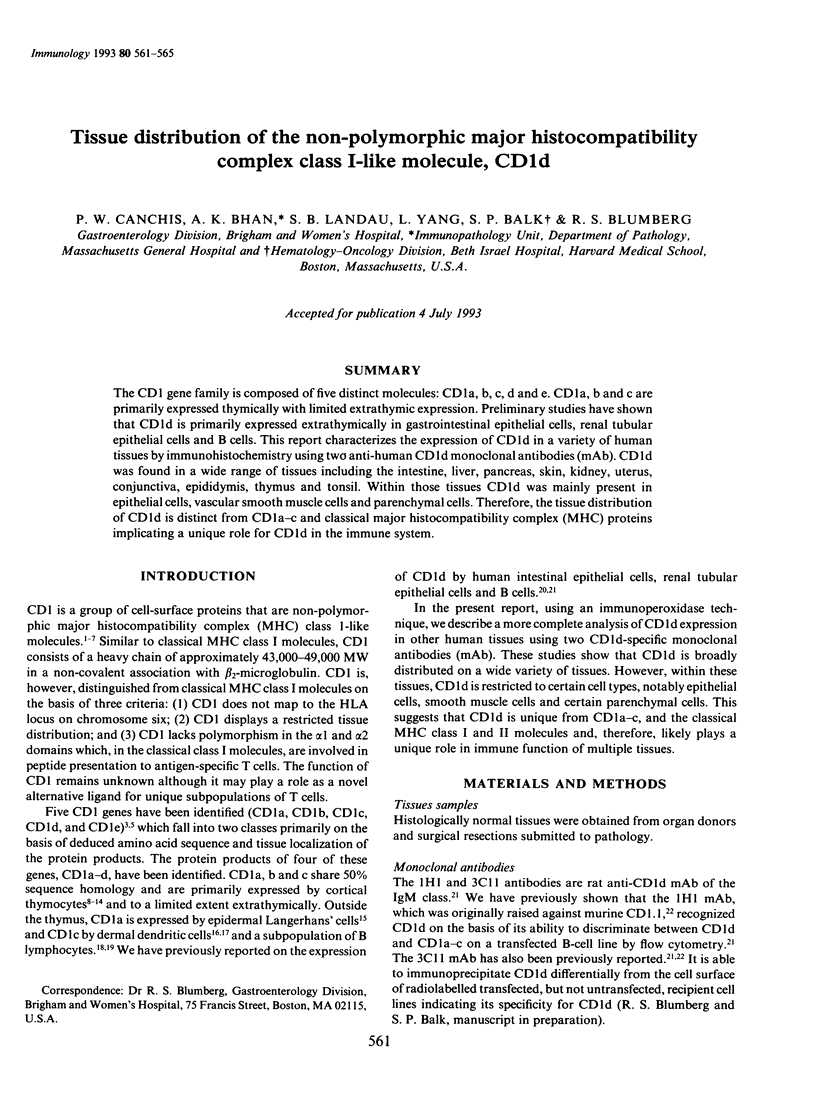
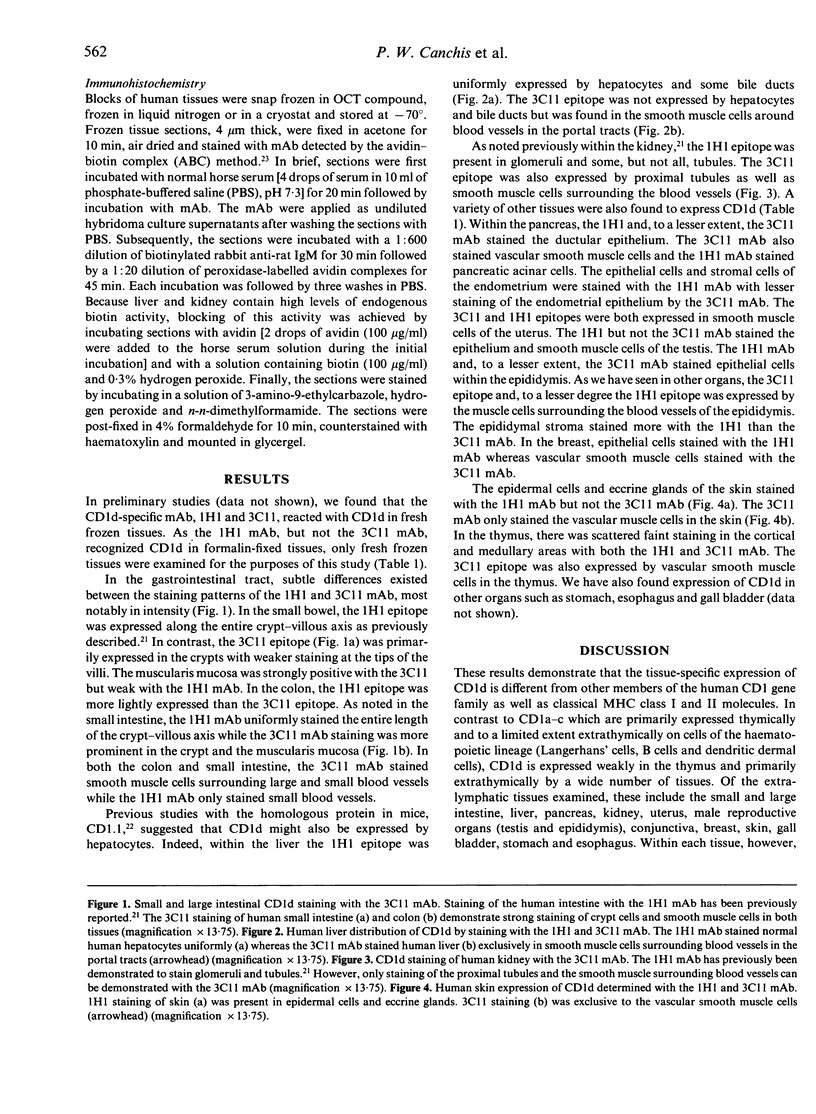
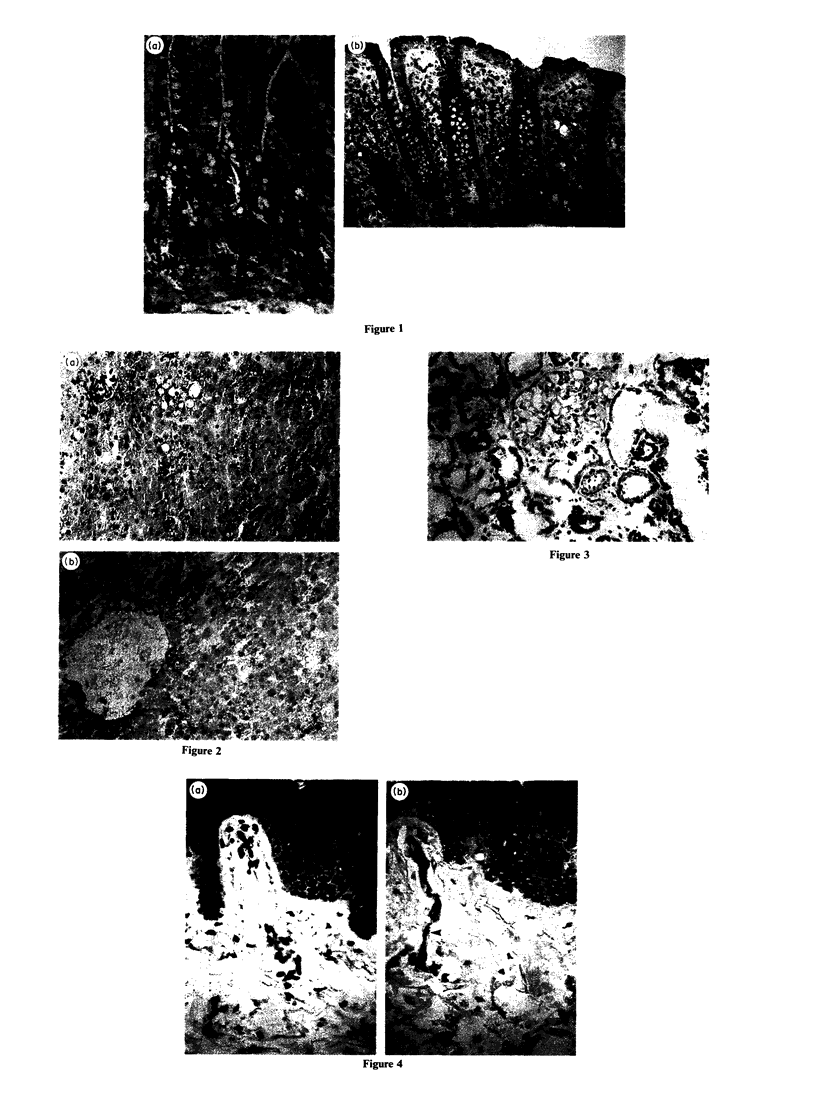
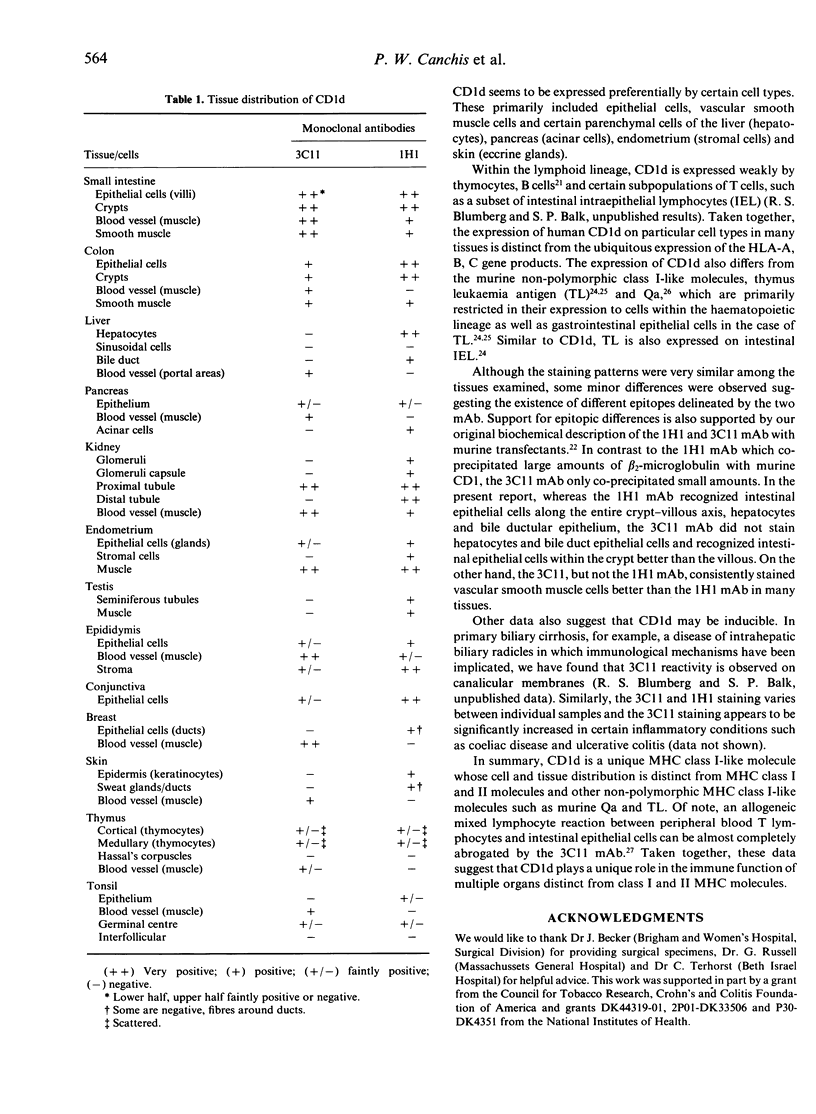
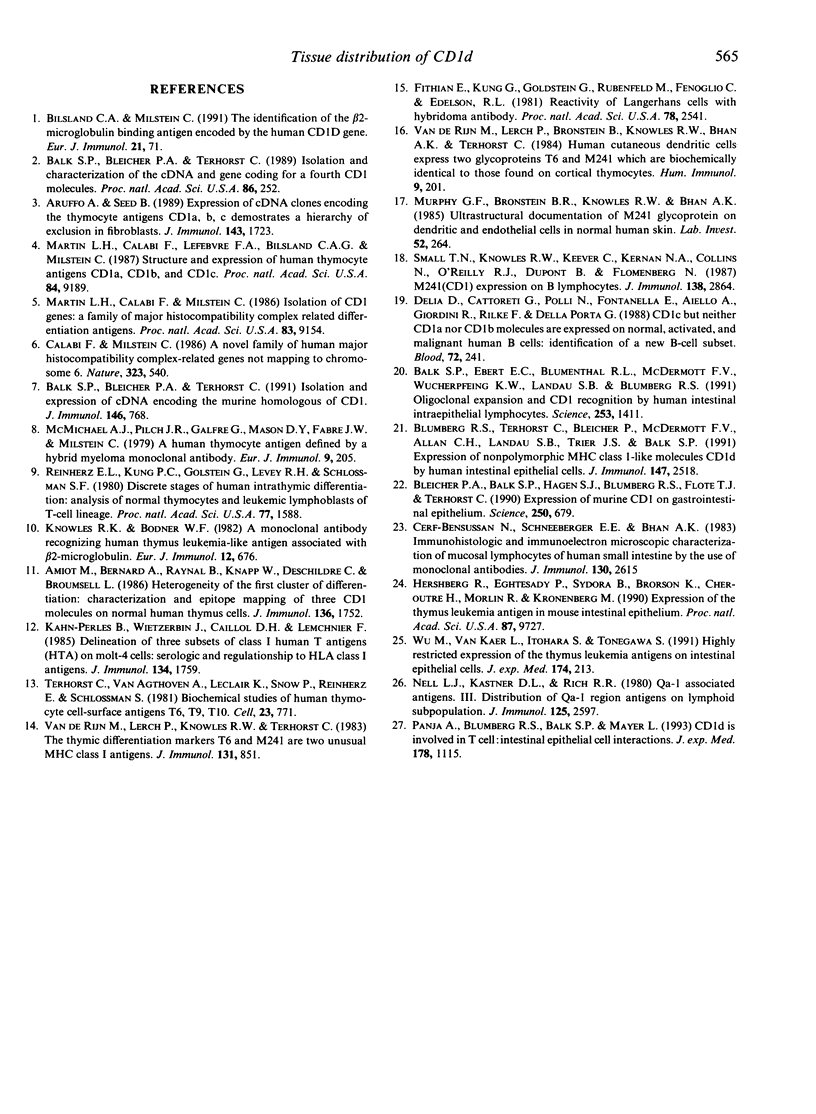
Images in this article
Selected References
These references are in PubMed. This may not be the complete list of references from this article.
- Amiot M., Bernard A., Raynal B., Knapp W., Deschildre C., Boumsell L. Heterogeneity of the first cluster of differentiation: characterization and epitopic mapping of three CD1 molecules on normal human thymus cells. J Immunol. 1986 Mar 1;136(5):1752–1758. [PubMed] [Google Scholar]
- Aruffo A., Seed B. Expression of cDNA clones encoding the thymocyte antigens CD1a, b, c demonstrates a hierarchy of exclusion in fibroblasts. J Immunol. 1989 Sep 1;143(5):1723–1730. [PubMed] [Google Scholar]
- Balk S. P., Bleicher P. A., Terhorst C. Isolation and characterization of a cDNA and gene coding for a fourth CD1 molecule. Proc Natl Acad Sci U S A. 1989 Jan;86(1):252–256. doi: 10.1073/pnas.86.1.252. [DOI] [PMC free article] [PubMed] [Google Scholar]
- Balk S. P., Bleicher P. A., Terhorst C. Isolation and expression of cDNA encoding the murine homologues of CD1. J Immunol. 1991 Jan 15;146(2):768–774. [PubMed] [Google Scholar]
- Balk S. P., Ebert E. C., Blumenthal R. L., McDermott F. V., Wucherpfennig K. W., Landau S. B., Blumberg R. S. Oligoclonal expansion and CD1 recognition by human intestinal intraepithelial lymphocytes. Science. 1991 Sep 20;253(5026):1411–1415. doi: 10.1126/science.1716785. [DOI] [PubMed] [Google Scholar]
- Bilsland C. A., Milstein C. The identification of the beta 2-microglobulin binding antigen encoded by the human CD1D gene. Eur J Immunol. 1991 Jan;21(1):71–78. doi: 10.1002/eji.1830210112. [DOI] [PubMed] [Google Scholar]
- Bleicher P. A., Balk S. P., Hagen S. J., Blumberg R. S., Flotte T. J., Terhorst C. Expression of murine CD1 on gastrointestinal epithelium. Science. 1990 Nov 2;250(4981):679–682. doi: 10.1126/science.1700477. [DOI] [PubMed] [Google Scholar]
- Blumberg R. S., Terhorst C., Bleicher P., McDermott F. V., Allan C. H., Landau S. B., Trier J. S., Balk S. P. Expression of a nonpolymorphic MHC class I-like molecule, CD1D, by human intestinal epithelial cells. J Immunol. 1991 Oct 15;147(8):2518–2524. [PubMed] [Google Scholar]
- Calabi F., Milstein C. A novel family of human major histocompatibility complex-related genes not mapping to chromosome 6. Nature. 1986 Oct 9;323(6088):540–543. doi: 10.1038/323540a0. [DOI] [PubMed] [Google Scholar]
- Cerf-Bensussan N., Schneeberger E. E., Bhan A. K. Immunohistologic and immunoelectron microscopic characterization of the mucosal lymphocytes of human small intestine by the use of monoclonal antibodies. J Immunol. 1983 Jun;130(6):2615–2622. [PubMed] [Google Scholar]
- Delia D., Cattoretti G., Polli N., Fontanella E., Aiello A., Giardini R., Rilke F., Della Porta G. CD1c but neither CD1a nor CD1b molecules are expressed on normal, activated, and malignant human B cells: identification of a new B-cell subset. Blood. 1988 Jul;72(1):241–247. [PubMed] [Google Scholar]
- Fithian E., Kung P., Goldstein G., Rubenfeld M., Fenoglio C., Edelson R. Reactivity of Langerhans cells with hybridoma antibody. Proc Natl Acad Sci U S A. 1981 Apr;78(4):2541–2544. doi: 10.1073/pnas.78.4.2541. [DOI] [PMC free article] [PubMed] [Google Scholar]
- Hershberg R., Eghtesady P., Sydora B., Brorson K., Cheroutre H., Modlin R., Kronenberg M. Expression of the thymus leukemia antigen in mouse intestinal epithelium. Proc Natl Acad Sci U S A. 1990 Dec;87(24):9727–9731. doi: 10.1073/pnas.87.24.9727. [DOI] [PMC free article] [PubMed] [Google Scholar]
- Kahn-Perles B., Wietzerbin J., Caillol D. H., Lemonnier F. Delineation of three subsets of class I human T antigens (HTA) on Molt-4 cells: serologic and regulatory relationship to HLA class I antigens. J Immunol. 1985 Mar;134(3):1759–1765. [PubMed] [Google Scholar]
- Knowles R. W., Bodmer W. F. A monoclonal antibody recognizing a human thymus leukemia-like antigen associated with beta 2-microglobulin. Eur J Immunol. 1982 Aug;12(8):676–681. doi: 10.1002/eji.1830120810. [DOI] [PubMed] [Google Scholar]
- Martin L. H., Calabi F., Lefebvre F. A., Bilsland C. A., Milstein C. Structure and expression of the human thymocyte antigens CD1a, CD1b, and CD1c. Proc Natl Acad Sci U S A. 1987 Dec;84(24):9189–9193. doi: 10.1073/pnas.84.24.9189. [DOI] [PMC free article] [PubMed] [Google Scholar]
- Martin L. H., Calabi F., Milstein C. Isolation of CD1 genes: a family of major histocompatibility complex-related differentiation antigens. Proc Natl Acad Sci U S A. 1986 Dec;83(23):9154–9158. doi: 10.1073/pnas.83.23.9154. [DOI] [PMC free article] [PubMed] [Google Scholar]
- McMichael A. J., Pilch J. R., Galfré G., Mason D. Y., Fabre J. W., Milstein C. A human thymocyte antigen defined by a hybrid myeloma monoclonal antibody. Eur J Immunol. 1979 Mar;9(3):205–210. doi: 10.1002/eji.1830090307. [DOI] [PubMed] [Google Scholar]
- Murphy G. F., Bronstein B. R., Knowles R. W., Bhan A. K. Ultrastructural documentation of M241 glycoprotein on dendritic and endothelial cells in normal human skin. Lab Invest. 1985 Mar;52(3):264–269. [PubMed] [Google Scholar]
- Nell L. J., Kastner D. L., Rich R. R. Qa-1-associated antigens. III. Distribution of Qa-1 region antigens on lymphoid subpopulations. J Immunol. 1980 Dec;125(6):2597–2603. [PubMed] [Google Scholar]
- Panja A., Blumberg R. S., Balk S. P., Mayer L. CD1d is involved in T cell-intestinal epithelial cell interactions. J Exp Med. 1993 Sep 1;178(3):1115–1119. doi: 10.1084/jem.178.3.1115. [DOI] [PMC free article] [PubMed] [Google Scholar]
- Reinherz E. L., Kung P. C., Goldstein G., Levey R. H., Schlossman S. F. Discrete stages of human intrathymic differentiation: analysis of normal thymocytes and leukemic lymphoblasts of T-cell lineage. Proc Natl Acad Sci U S A. 1980 Mar;77(3):1588–1592. doi: 10.1073/pnas.77.3.1588. [DOI] [PMC free article] [PubMed] [Google Scholar]
- Small T. N., Knowles R. W., Keever C., Kernan N. A., Collins N., O'Reilly R. J., Dupont B., Flomenberg N. M241 (CD1) expression on B lymphocytes. J Immunol. 1987 May 1;138(9):2864–2868. [PubMed] [Google Scholar]
- Terhorst C., van Agthoven A., LeClair K., Snow P., Reinherz E., Schlossman S. Biochemical studies of the human thymocyte cell-surface antigens T6, T9 and T10. Cell. 1981 Mar;23(3):771–780. doi: 10.1016/0092-8674(81)90441-4. [DOI] [PubMed] [Google Scholar]
- Wu M., van Kaer L., Itohara S., Tonegawa S. Highly restricted expression of the thymus leukemia antigens on intestinal epithelial cells. J Exp Med. 1991 Jul 1;174(1):213–218. doi: 10.1084/jem.174.1.213. [DOI] [PMC free article] [PubMed] [Google Scholar]
- van de Rijn M., Lerch P. G., Bronstein B. R., Knowles R. W., Bhan A. K., Terhorst C. Human cutaneous dendritic cells express two glycoproteins T6 and M241 which are biochemically identical to those found on cortical thymocytes. Hum Immunol. 1984 Apr;9(4):201–210. doi: 10.1016/0198-8859(84)90025-9. [DOI] [PubMed] [Google Scholar]
- van de Rijn M., Lerch P. G., Knowles R. W., Terhorst C. The thymic differentiation markers T6 and M241 are two unusual MHC class I antigens. J Immunol. 1983 Aug;131(2):851–855. [PubMed] [Google Scholar]




